Pages
▼
5/27/14
Help Your Health: Some good reasons to eat egg for breakfast
Help Your Health: Some good reasons to eat egg for breakfast: -Eggs help with brain development and memory.Choline, an essential nutrient found in eggs, stimulates brain development and function. It...
Help Your Health: Whether honey crystallization is reason to its poo...
Help Your Health: Whether honey crystallization is reason to its poo...: If the honey is placed in a high temperature, will not granulation but it will lose most of its properties.So some honey manufacturer he...
Help Your Health: Nice foods to boost your brain power
Help Your Health: Nice foods to boost your brain power: -Berries. Getting beneficial anti-oxidative compounds like vitamins C, E, beta-carotene and other nutrients through food may help preven...
5/25/14
5/20/14
10 Weird Things Found at the Bottom of the Sea
The sea is a mystical place for all of us because it is unknown the mysteries that lurk within. We have compiled a list of the weirdest things ever found at the bottom of the sea.
1. Yonaguni
The massive, geometrically perfect and vast constructions in what has come to be called the Yonaguni monument are one of the great finds of the modern era presenting archeologists with a challening and mysterious case study off the coast of Japan.
2. Jurassic Era Microbes
Vast sections of the deeper oceans play host to undisturbed ancient populations of species long thought to be extinct and with little interaction with other species that have evolved to live in the planets changing conditions. These might be the closest we could actually get to a real 'Jurassic Park' with some of these species have been in continuous existence for more than 86 million years!
3. Lazarus Fish
Thought be extinct for more than 60 million years, scientists were startled to find stray populations of the Lazarus fish still in existence along the coasts of Africa and South East asia. Fortunately, the the Lazarus fish has no commercial or gastronomic value, and is therefore likely to be conserved very effectively.
4. Thonis
Discovered in 2000, Ancient Heracleion, later known as Thonis was a once great city submerged by rising sea levels in the meditteranean. Although many of the artifacts can not be removed from site, the ocean has preserved many of the materials that have been recovered phenomenally well.
5. Antikythera
The famous Antikythera mechanism is often hailed as one of the most important finds of the 20th century. This gear like object is in fact, the worlds first analog computer. Its highly complex mechanical function is rumoured to have allowed far reaching progress in mathematics and astronomy for the ancient greeks.
6. Doomed Emeralds
Diver and treasure hunter Jay Miscovich is credited with discovering the infamous Doomed Emeralds off the coast of Florida. The find was noted for bringing a lot of coverage and piquing the interest of federal officials in the value of Miscovichs assets and other finds. This ultimately led to Miscovich taking his own life, and the emeralds reputation was cemented.
7. Pirate Treasure
Pirate ships with their often exotic armory and decorations, and their value as being avant-garde collectors items have always fascinated divers and deep sea archeologists. Treasure hunters too are inspired by the potential for "hidden treasure" on ships that were sunk fully loaded.
8. Bullion Treasure
World war era bullion in gold and silver gets a lot of publicity as they tend to be very high value finds, and have a more recent historical background to them. Famous cases exist of findings of Nazi Silver, and British silver on ships sunk on voyages. Most of the time less than 50% of the total value is recovered in these finds and therefore they tend to hold continued public interest.
9. Atocha Motherlode
In 1985, after a 17 year search, Mel Fisher discovered the underwater wreckage of the famous Nuestra Senora de Atocha. The ship sank for unknown reasons with precious cargo onboard, off the Florida Keys. It is currently one of the biggest and most valuable finds in history, at $450 million.
10. Colossal Squid
The mythical Giant Squid from Jules Vernes famous 20,000 leagues under the sea, turned out to be much more than just a myth, as there have been about half a dozen documented sighting of these majestic beasts over the last 100 years. These amazing and reclusive deep sea creatures can measure as much as 15 metres in length.
Amazing 3D Pen Art
Have your ever wondered if your sci-fi fantasies could turn into reality? Imagine being able to draw objects in the air. We all have tried air writing, but it never materialised! But now it is possible with the lix doodle pen. You can simply use it to write into thin air. Create objects and have fun. It basically uses plastic thread made through a pateneted process which melts and cools while moving through the pen. You can make objects as big as 11 foot with it! Just make sure you provide a base to the object. Because though you can write in the air now, you still can not make them hover in mid air!
Lix was devised by Ismail Baran and Anton Suvorov in Belgium, and Delphine Wood in London.
The idea behind the Lix 3D pen, which can draw solid lines through the air with no need for paper. They launched a Kickstarter campaign just recently to get their product off of the ground and have already gathered more than 3 times their initial funding goal
Lix 3D pen enables you to doodle in the air. This professional tool offers you the comfort and pushes your creativity to another level.
Watch how this lix 3D pen works. Just follow the link given below.
" rel="nofollow">
These are some of the amazing art create by the lix pen. Cool isn't it?
As high-tech as the Lix pen seems, the technology behind it is relatively simple. After plugging it into a power source and waiting for it to heat up, the artist or inventor inserts a thin plastic filament through the back that melts as it progresses through the pen – much like a hot glue gun.
This melted plastic is cooled the moment it exits the pen, meaning that it can create lines of plastic rising up from their initial flat surface. With a bit of practice, the pen’s creators have been able to create mind-bending works of art illustrating the pen’s versatility and capability in different fields.
The components of the pen include a micro planetary motor.
The Lix pen charges from a USB 3.0 port. Like 3Doodler, Lix can take ABS (petroleum-based plastic) or PLA (plant-based) filaments, and outputs solid lines as you move the pen through the air.
It is lightweight and portable so you could put it in your bag and travel with it! Have fun and doodle anywhere anytime you want!
Freshest Clothes Ever
The Dehumidifying Air Rod is an innovative hanger rod for your cupboard. It has elements and segments where Dehumidifying, Deodorizing and Air Freshener agents are integrated into the design. The purpose of course is to ensure you have the freshest and cleanest set of clothes in town. Naturally you will look and feel your best!
Designers: Gwang Chae Jung & Hansung University Students
-
|
The World's Most Exotic Pets
Monkeys, Lions and Chimpanzees are animals we often see in the wild or on the Discovery Channel. The following are some exotic albeit expensive pets that can be legally bought. These animals, however do come with a heavy price tag and that is not including the upkeep.
13. Bengal Cat
Price Tag: $800-$3,000
Price Tag: $800-$3,000
The Bengal Cat is bred by mating a domestic black shorthaired cat with an Asian Leopard cat. As with many hybrids the goal is to create a domestic cat in size and demeanor with the exotic Asian Leopard Cat appearance and coloring. As with most hybrid cats, the breed becomes more and more domesticated with each successive generation, therefore the ideal domesticated breed would be at least three to five generations removed from the original breed.
12. Snow Macaque
Price Tag: $3,500
The Snow Macaque is considered a threatened species as we continue to encroach on more and more of the animal's habitat. Due to this fact, coveted licenses and special permits are mandated to own this very rare animal. The Snow Macaque is a smaller primate with a lifespan of over 25 years with the distinguishing feature of a hairless red face.
11. Squirrel Monkey
Price Tag: $4,000
This primate is about the size of a squirrel thus it's name. Generally the squirrel monkey does not get any bigger than 2 pounds and is considered a very social, affectionate and peaceful animal. These complacent characteristics make the animal a highly desired pet, however as with most of these animals, many states do not allow them to be privately owned.
10. Chinese Crested Hairless Puppies
Price Tag: $4,000-$5,000
These dogs weigh about 5 to 12 lbs and are very vivacious, alert and friendly animals. Considered to be one of the rarest dogs, these dogs are prone to sunburning on a hot and clear day. The dogs first originated in Africa and the animals is most often found to be a very pleasant companion that lives for over 10 to 12 years.
9. Savannah Cat
Price Tag: $4,000-$10,000

9. Savannah Cat
Price Tag: $4,000-$10,000
Bred in a similar process to the Bengal Cat, the Savannah Cat is bred by mating the African Serval with a smaller domestic cat. The Savannah inherently has a much more difficult breeding process, because an African Serval is 40lbs and undomesticated and breeding it with a domestic house cat is problematic. Concurrently, the gestation periods between the two animals are different. Due to these factors, the Savannah is a more expensive and rare breed of cat.
8. Mona Guenon
Price Tag: $6,000
The Mona Guenon's natural habitat is within the Western African tropical forests, however this animal is capable of adapting to any forest environment. Therefore, despite special permits and licenses to own this animal, it is not considered an endangered specie.
7. Debrazzas Monkey
Price Tag: $10,000
The DeBrazza's Monkey is easily recognized by its white beard and yellowish gray fur. The animal will generally live for about 22 years. Though many people do shell out the hefty price for this primate, they become disappointed when the docile and tender babies grow to become unpredictable and hostile adults.
6. Striped Ball Python
Price Tag: $10,000
Master Python Breeder, Bob Clark states that he has an exclusive on this genetic striped ball python. The prominent stripe is what makes this animal very unique. More clearly, the striped ball showcases a yellow dorsal stripe with a a black border, clearly differentiating them from any other snake.
5. Hyacinth Macaw
Price Tag: $6,500-12,000
Macaws overall are very expensive. The Hyacinth Macaw exhibiting beautifully vibrant coloring, generally commands $20,000 a pair. Physically these birds are about 40 inches long and have a bright blue coloring. Their wing span is about four feet and these birds make popular pets despite their expensive price tag.
4. Reticulated Albino Type II Tiger Python
Price Tag: $15,000
Master Python Breeder, Bob Clark's Reticulated Albino Type II Tiger Pythons sell for $15,000 each. An extremely rare breed, these pythons showcase a co-dominant tiger pattern, making them extremely popular in the snake world.
3. Lavender Albino Python Female
Price Tag: $20,000
This red-eyed snake is lavender in color, under a vibrant yellow pattern. Also available from python breeder Bob Clark, the rarity has fueled demand.
2. Chimpanzee
Price Tag: $60,000-$65,000
Chimpanzees are highly intelligent primates and are closely related to humans. Chimpanzees weigh about 115 lbs and the male is slightly larger than the female. The natural habitat of the Chimpanzee is within central Africa and western Africa. Though an endangered specie, Chimps are legal pets in some states.
1. White Lion Cubs
Price Tag: $138,000
The very rare White Lion is because of a a recessive gene and the animals are not considered to be albino. The White Lion's eye color is similar to the regular lion, however the coat pigmentation and skin are not. Due to its price, demand, upkeep and scarcity, the White Lion remains one of the most difficult animals in the world to obtain.
Dual Hearing – Speaker and Earbuds!
The Dual-Mode Headphone is a Bluetooth headset that can be used in two ways: as an embedded speaker and as earbuds. The design for embedded speakers stems from the need of folks who are outdoorsy and who like to listen to music while doing their things. For example, when you cycle, jog or hike headphones shut out external sounds and can be dangerous. The embedded speaker in Dual-Mode Headphone lets you to listen to your favorite songs in the ‘open air’, without shutting out external noises.
In crowded places the ear buds work the best. They attach magnetically to the sides of the headphone set.
How it works:
Designers: Yeom Ilsoo, Choi Eunji & Lee Nari for LG Electronics Inc.
-
|
World's Biggest Airplanes : Huge Aviation
For a few thousand years the biggest things in the skies were only in our imaginations, flying figments of myth and fable: the Roc from Sinbad’s tales, the Garuda bird from the Mahabharata, the Thunderbird from North America, the Brazilian Blue Crow, and other high-flying nightmares or soaring benevolent gods and spirits.
Sputtering, Creaking, Terrifying Monsters
The Wright Brothers are often given most of the recognition for the first powered flight but Gustave Whitehead, Alexander Feodorovich Mozhaiski, Clement Ader, and many others should get a share of the fame, too. Whoever is responsible, it wasn’t long before the skies were full of sputtering, creaking, and – for the most part – very unreliable aeronautical devices.

(futuristic art by Harry Grant Dart)
It took the first world war to change aircraft from a killing and maiming hobby for the rich to a killing and maiming war machine. War helped advance the science of flight and necessitated bigger planes.
One monster plane of that time was Igor Sikorsky's Ilya Murometz, a huge improvement over his legendary Russky Vitaz, the first four engine aircraft. But the Ilya Murometz didn't begin as a beast of the skies. Originally designed as a luxurious passenger liner featuring electric lighting, heat, a bathroom, and even a glass floor, the bomber must have been amusing as well as terrifying to its wealthy passengers.
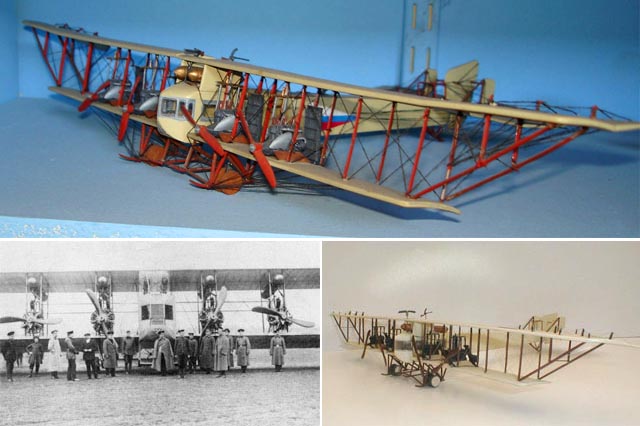
(images credit: histarmar.com.ar)
Another iteration of such approach was Tupolev ANT-20 "Maxim Gorky":
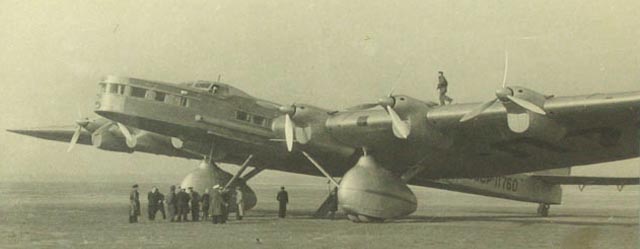
And a really huge Russian monster plane from the early 1930s: Ka-7 (more info), named after engineer Kalinin, not the famous political figure.
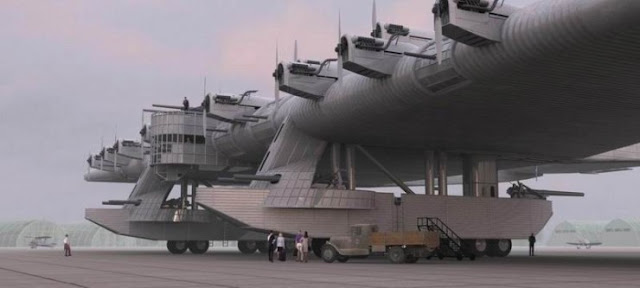
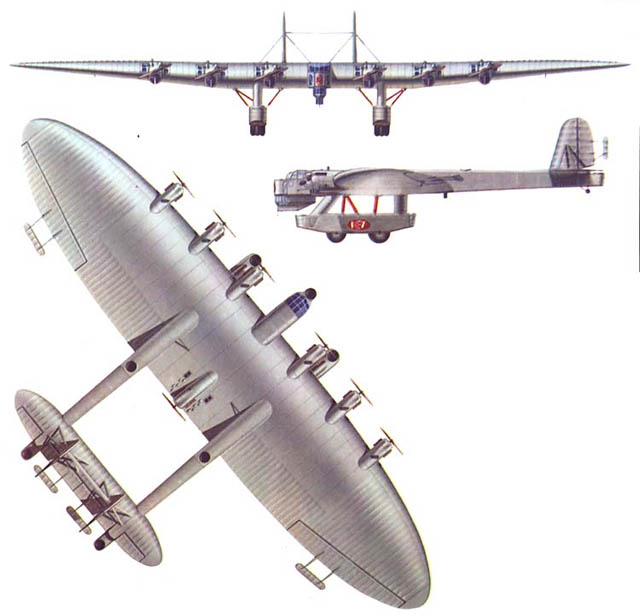
(images via Modelist-Konstruktor, 1989)
Art and Elegance Between Wars
In the years between wars, airplanes kept getting bigger. Outrageous concepts like Norman Bel Geddes Airliner Number 4 appeared, featuring 9 decks of luxury hotel accommodation, bars and engine rooms:
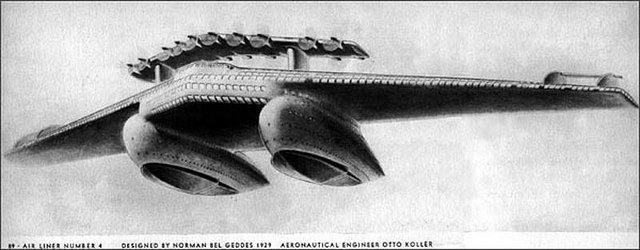

It would sleep 606 passenger in comfort, easily bringing them across Atlantic. More images and info about Bel Geddes fantastic dream planes are here. It seems to be a logical development of 1910s British Airliner of the Future:
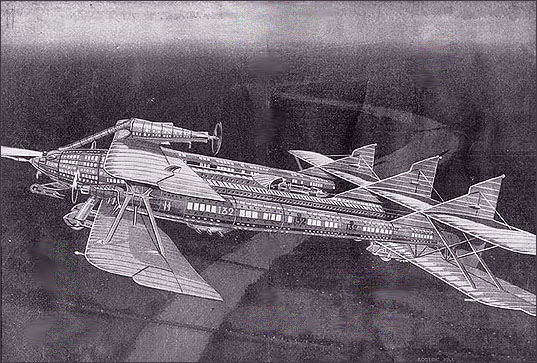
(image via)
Don't miss also this "Freak of the Month" concept from Modern Mechanics, 1931:
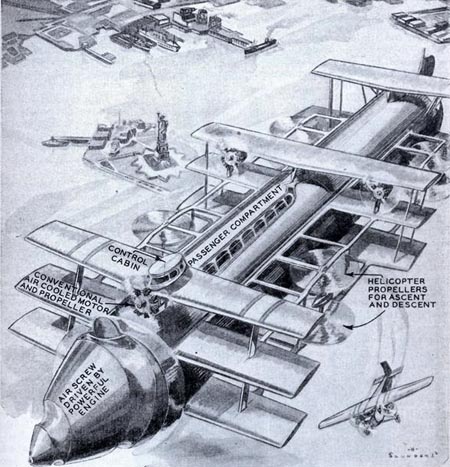
(image credit: modernmechanix)
But let us get back from aviation dreams to reality. Take the elegant Handley Page HP42, for instance: a four-engined beauty with an impressive track record of no crashes while being used as an airliner -- which gives you an idea of how safe it was to fly back then.
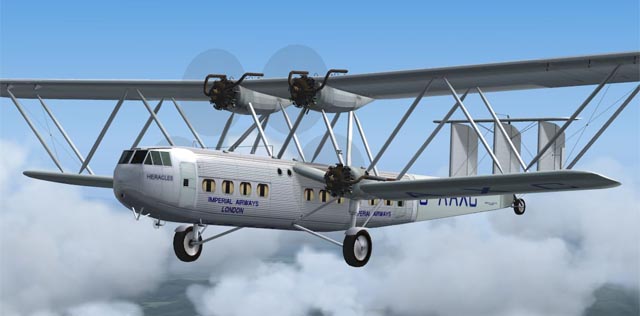
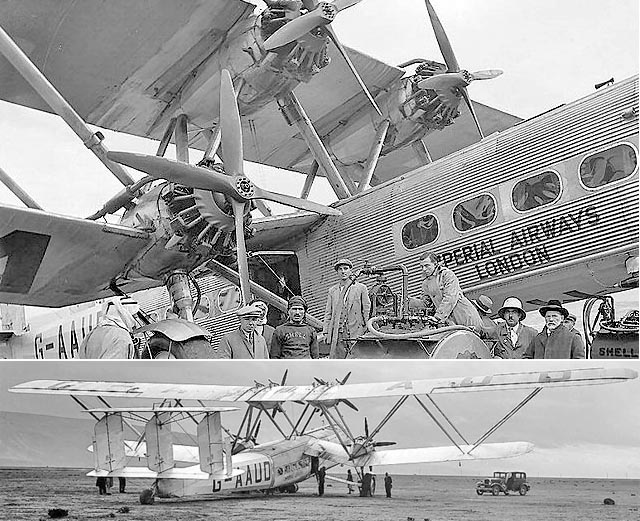
(images via)
One of the larger and more beautiful aircraft in the next few decades was the awesome 1936 Boeing Stratoliner. Unfairly called a ‘whale’ because of its chubbiness, the plane was not only huge but also state of the art; today we enjoy flying in pressurized comfort because of technology premiered in the silver flying fish of the Stratoliner.
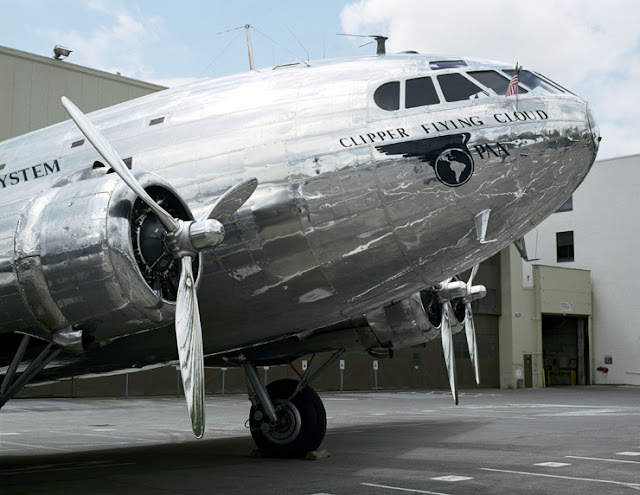
Another aircraft both immense and legendary - The H-4 Hercules. Arguably the standard by which “huge aircraft” are measured –- as well as how "completely screwed up" is defined. Its one and only flight was in 1947, where it flew for around a mile, reaching altitude of 70 feet. Originally planned as the ultimate military transport, it is more commonly known as its hated -- at least by its creator Howard Hughes -- moniker, the Spruce Goose.

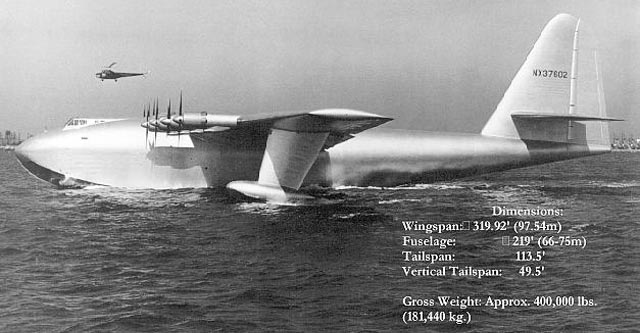
(image credit: Bettman/CORBIS)
The aircraft had originally been ordered by the US government during World War II as a giant cargo plane for the armed troops and tanks. Howard Hughes's creation was the world's largest plane at the time and is still the largest flying boat ever built. It also holds records for the largest wingspan at 97.5 meters, tallest airplane at 24.2 meters, and the largest aircraft ever made from wood.
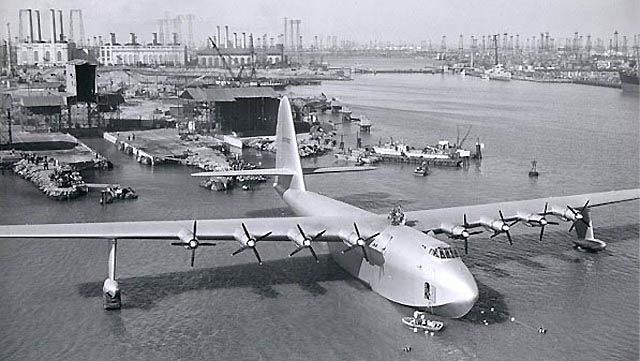
Nazi's Ugly Brute
Art and elegance may have been one of the early fatalities in the second world war, but striving to have the biggest (anything) certainly wasn’t.
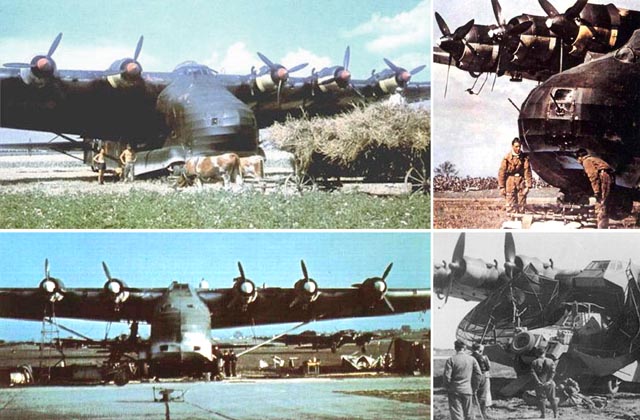
To call the Messerschmitt Me 321 big is like calling 1939 to 1945 unpleasant. Created originally as a glider, the Gigant could haul an insanely large amount of cargo. And an insane bunch of soldiers: 130 plus hardware ... 23 tons of hardware.
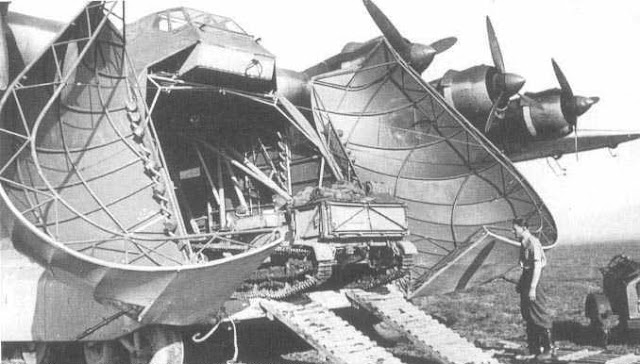
(images via)
Because the Gigant was so huge, getting the damned thing into the air was, at best, problematic. First it was towed up with a pair of Heinkel 111 bombers, which was alternatively unsuccessful or disastrous. Then they tried fusing two 111s together to make a Frankenstein’s monster of a machine –- almost as bestial as the Gigant itself. Finally the Luftwaffe stuck engines on the Me321, which made an ugly brute even uglier but at least it got off the ground.
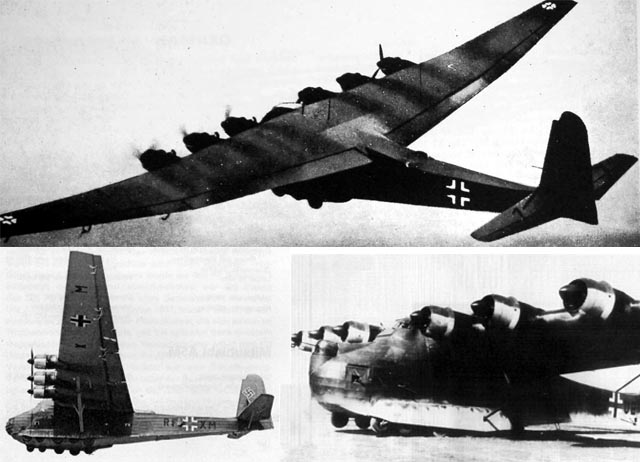
Heavy Bombers of the (Potential) Doomsday
On the other side of the war was an eagle, a silvery steel bird of prey: the huge and beautiful B-29 Superfortress. Although getting the immense B-29 up to its ceiling of 40,000 feet was a struggle, once it got up there nothing could reach it or, at 350 mph, catch it. Even if something managed to come close to it, its formidable defenses could cut any threat to shreds. Featuring many impressive advancements, and some frustrating problems, the plane was kept on active duty long into the Korean war.
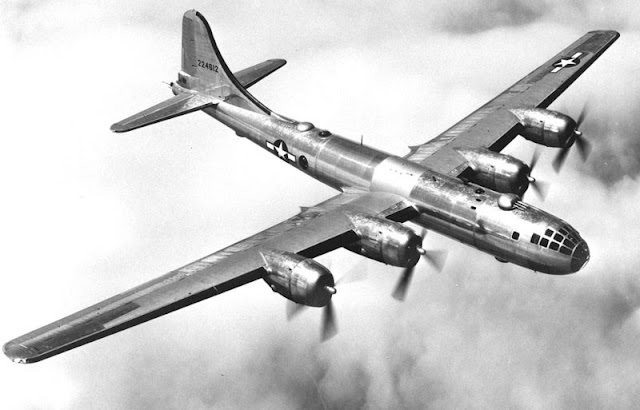
(image via)
With the advent of jet power, aircraft designers began to think really big. Think of your average doomsday film and you immediately picture the roaring ascent of smoke-blasting, eight-engined, B-52 bombers. But before B-52 there was another huge American bomber: Convair B-36 "Peacemaker":
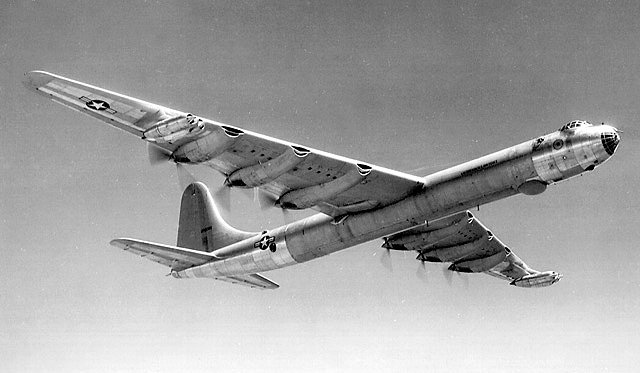
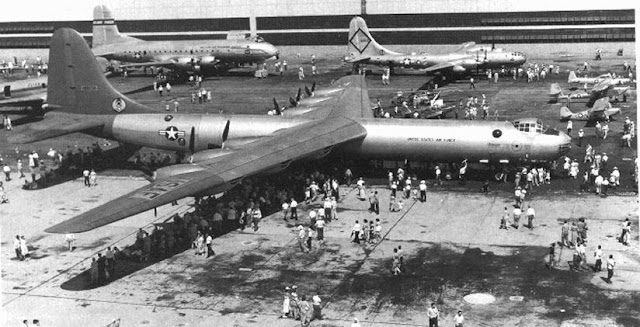
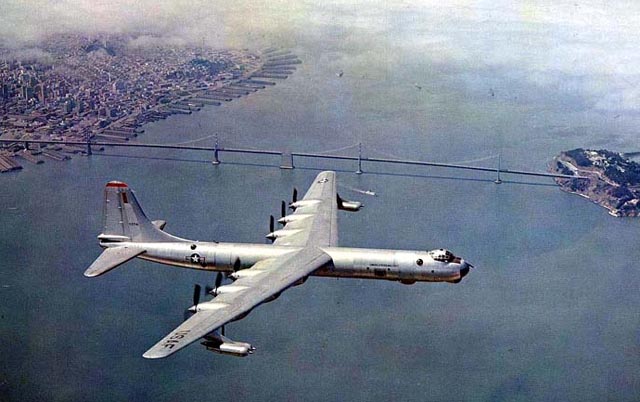
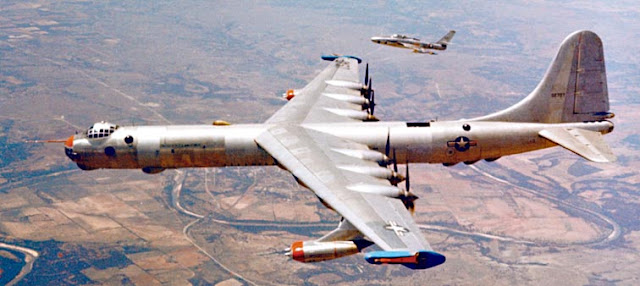
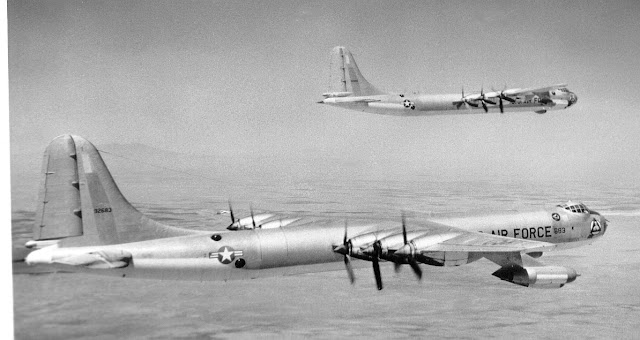
(images via)
Like the B-29, the B-52 "Stratofortress" was an aeronautical powerhouse, a heavy-lifting behemoth. And like the B-52, it was kept in service until … well, they are still being used today.

(image source: US Air Force)
Heavy bombers transforming into LEGO pieces in the minds of dazed Cold War engineers:
Arthur Kimes writes to us: "Soviets also proposed to stick together a bunch of big airplanes to make a REALLY huge one. Kind of like a Lego dream come true: In the early-mid 1950s the USAF had a plan to link 3 B-36s (wingtip to wingtip) to have a extended range delivery system. When this behemoth got close enough to the Soviet Union each would drop off a parasite fighter-bomber (probably the F-92 - which also was never built) and the released FBs would make a high-speed dash and drop a bomb on their targets. The B-36s would split up and return, the F-92s would have to try and find a friendly airfield in Turkey or something like that."
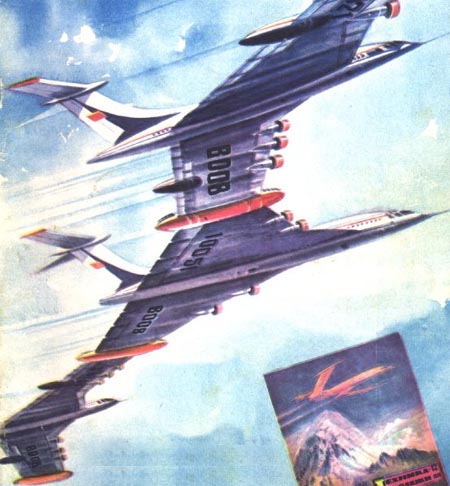
(image source: TM, 1975)
"When you consider the B-36 is still the largest bomber ever built, the idea of 3 of them flying joined at the wingtips is astounding."
The Ugliest Airplane Ever Built?
The Aero Spacelines Super Guppy looks more like a prop from a Japanese monster movie than a real airplane. The Guppy is also high on the irony meter as it was mostly used to haul nearly-completed components -- of other airplanes.

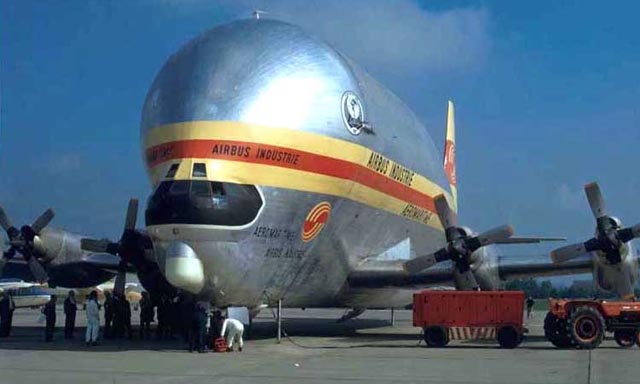
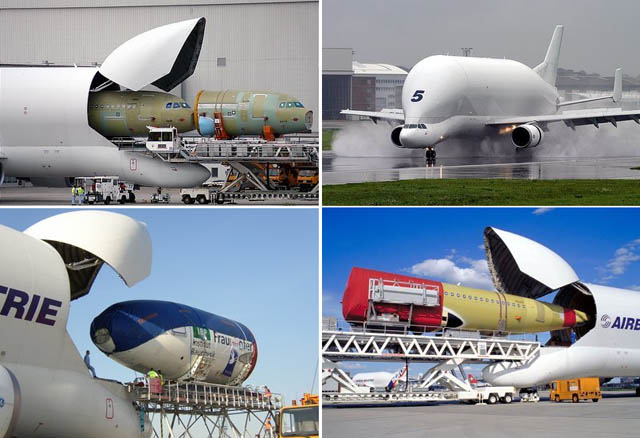
(images credit: Mischa Oordjik, Alastair T. Garoiner)
The Airbus A300-600ST (Super Transporter) or Beluga:
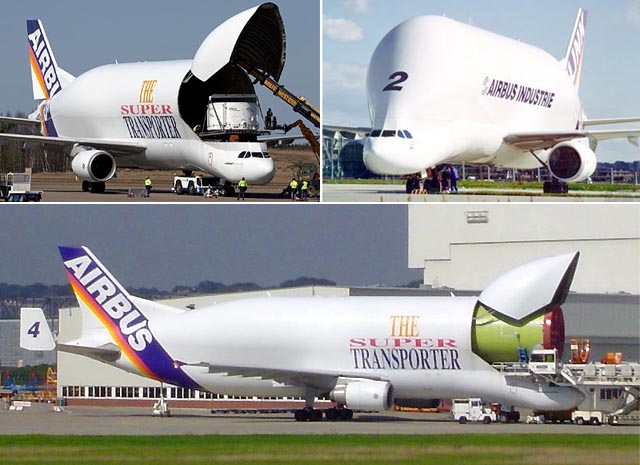
(images via)
Here is a Russian carrier VM-T "Atlant" used in a Buran and Energia space programs, which is perhaps the only airplane capable of carrying on its "shoulders" a load larger and heavier than itself:
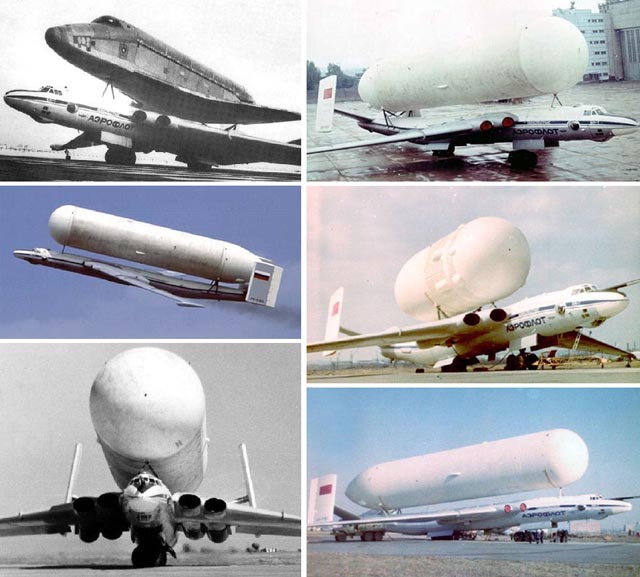
(images via)
Transporting a fuel tank for the second stage of Energia rocket:
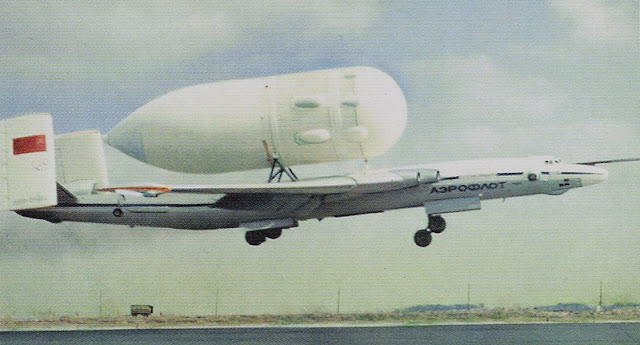
(image source: "Cosmonautics - A Colorful History" ed. by Dr. Wayne R. Matson)
Nuclear-Powered Lockheed Mothership
Nothing comes close in size to this unbelievable concept developed by Lockheed in the 1970s:
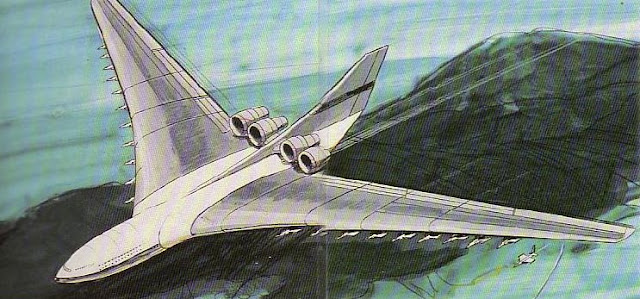
Note small "children" airplanes, attached to its wings... Its hard to imagine anything bigger flying in the skies, still retaining the shape of a common airliner. An aircraft of this size would have to land on water as a titanic "flying boat".
The Biggest Planes Flying Today
Unlike the B-29 and the B-52, which don’t show their size easily, the C-5 Galaxy would look insanely monstrous even on a postage stamp. To give you an idea of the Galaxy’s size, its wingspan is not just longer than the Wright Brothers’ first flight but the beast can also haul 180,000 pounds (which is about 90 tons). The C-5 was the world's largest plane when it was introduced in the late 1960s.

(image credit: Pervez Iqbal)
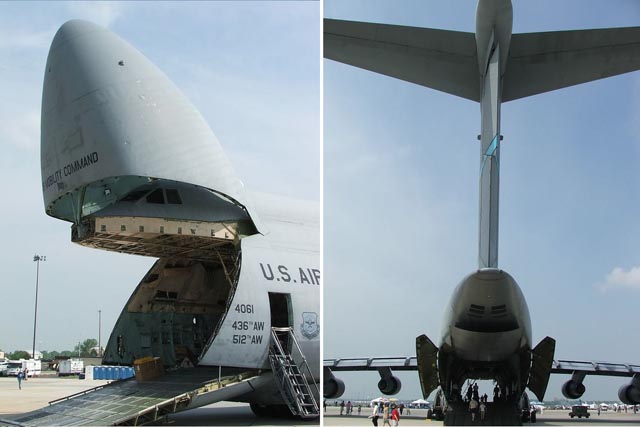
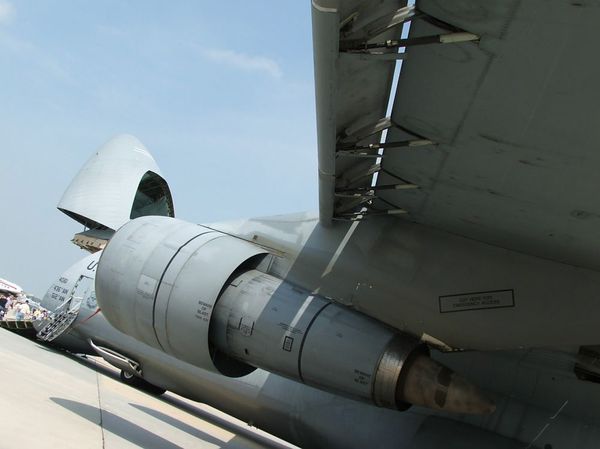
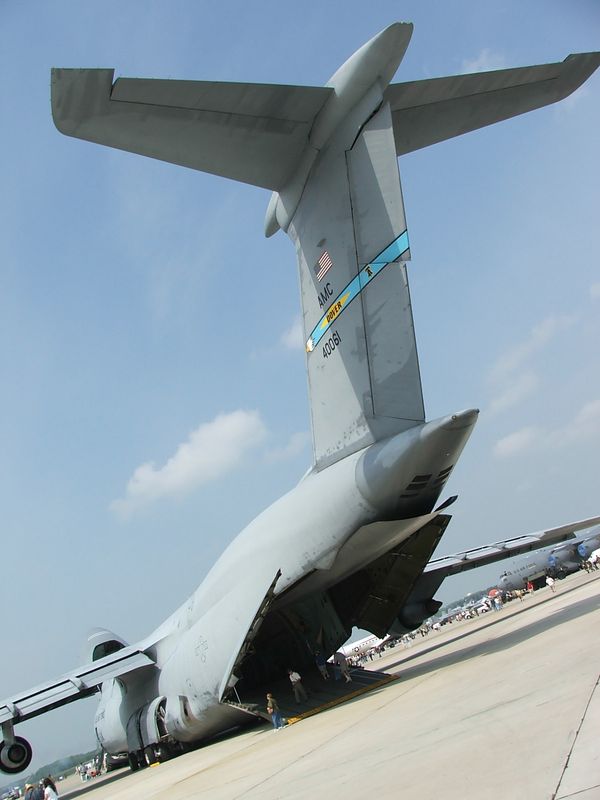
Arguably the biggest plane flying today, or ever, is Antonov An-225, a 6-engine beast that’s not only longer than the first flight in history but could probably carry one, two, or three whole aircraft museums. Numbers don’t mean much but here is an impressive one: the 225 can carry 550,000 pounds, which is 275 tons. Yes, you can say WOW.
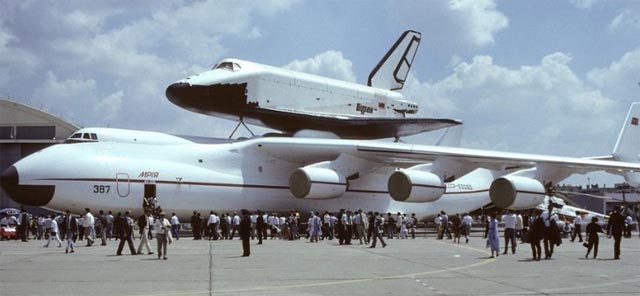
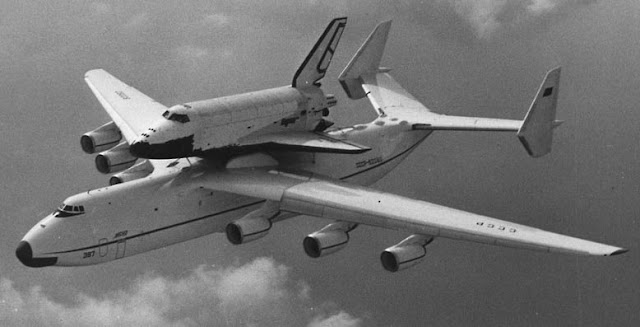
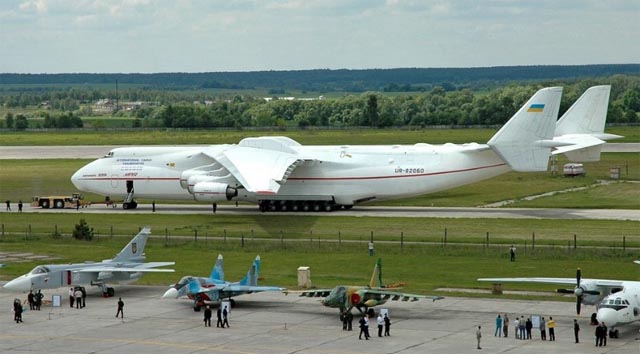
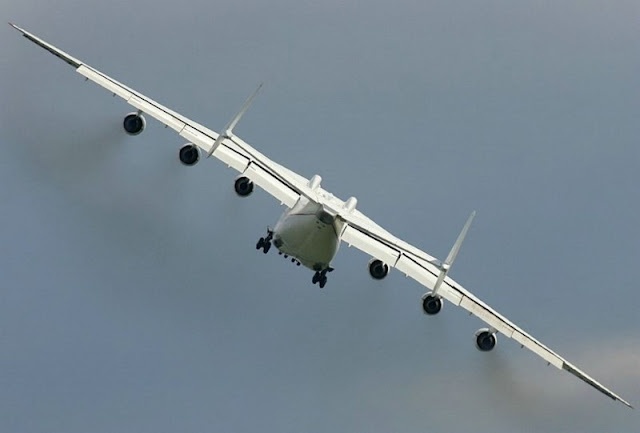
(image credit: Dmitry Pichugin)
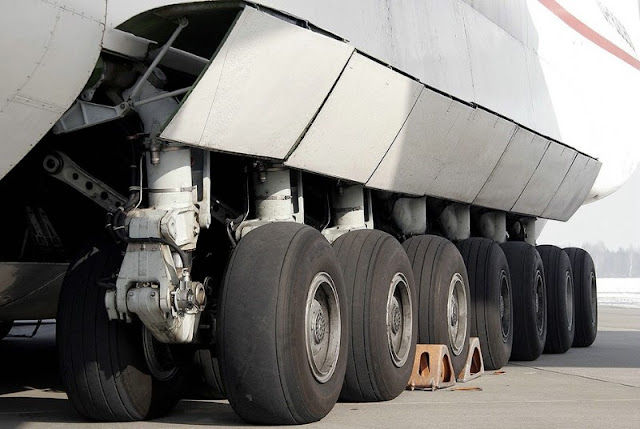
(image credit: Radek Oneksiak)
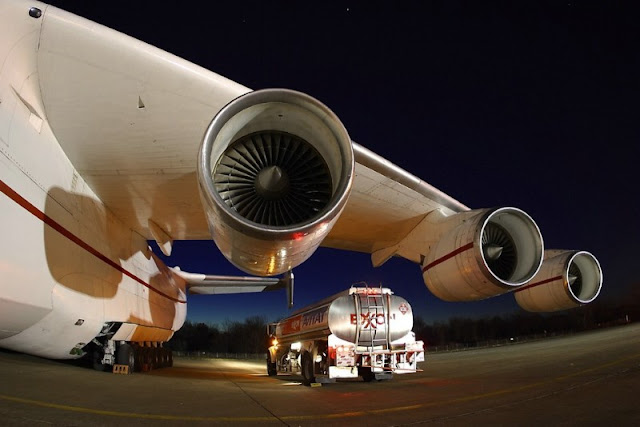
(image credit: airliners.net)

(images via)
This is a good dimension-comparison chart:
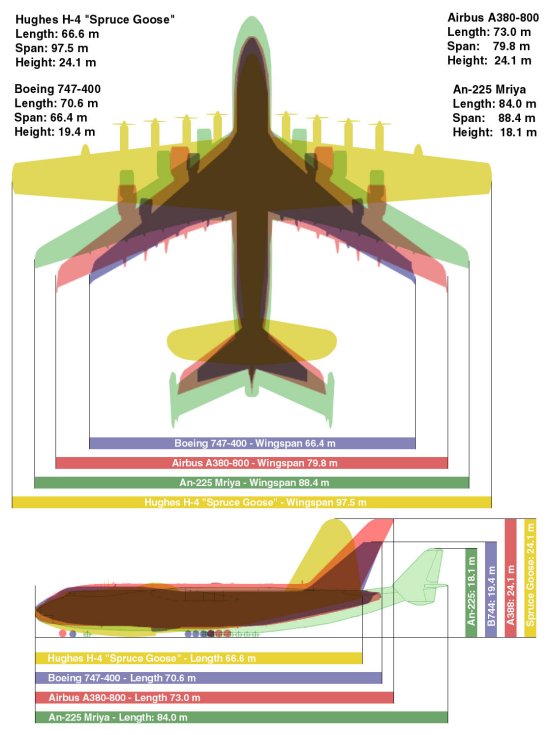
(image via)
When it comes to passenger aviation, Airbus A-380 is the current leader in size: this image shows its comparative size among other planes in the airport -
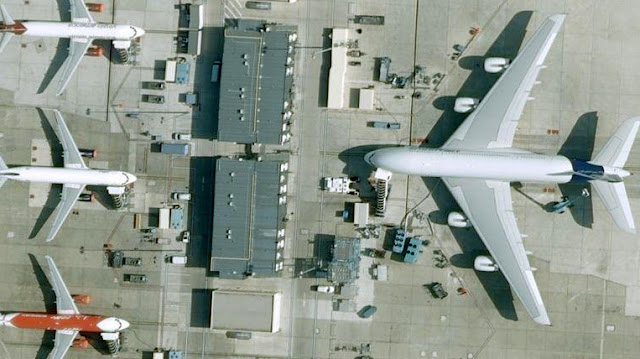
We used to have the Roc, the Garuda bird, the Thunderbird, Blue Crow, and other soaring myths. Now we have machines; airplanes so big they’re even greater than those ancient, and magnificent, dreams. Of course, there is another advantage to premium size - you can always claim your piece of the sky, and outright own the airstrip:
- See more at: http://www.funonthenet.in/articles/biggest-airplanes.html#sthash.Fxw3NZaV.dpufThe Wright Brothers are often given most of the recognition for the first powered flight but Gustave Whitehead, Alexander Feodorovich Mozhaiski, Clement Ader, and many others should get a share of the fame, too. Whoever is responsible, it wasn’t long before the skies were full of sputtering, creaking, and – for the most part – very unreliable aeronautical devices.

(futuristic art by Harry Grant Dart)
It took the first world war to change aircraft from a killing and maiming hobby for the rich to a killing and maiming war machine. War helped advance the science of flight and necessitated bigger planes.
One monster plane of that time was Igor Sikorsky's Ilya Murometz, a huge improvement over his legendary Russky Vitaz, the first four engine aircraft. But the Ilya Murometz didn't begin as a beast of the skies. Originally designed as a luxurious passenger liner featuring electric lighting, heat, a bathroom, and even a glass floor, the bomber must have been amusing as well as terrifying to its wealthy passengers.

(images credit: histarmar.com.ar)
Another iteration of such approach was Tupolev ANT-20 "Maxim Gorky":

And a really huge Russian monster plane from the early 1930s: Ka-7 (more info), named after engineer Kalinin, not the famous political figure.


(images via Modelist-Konstruktor, 1989)
Art and Elegance Between Wars
In the years between wars, airplanes kept getting bigger. Outrageous concepts like Norman Bel Geddes Airliner Number 4 appeared, featuring 9 decks of luxury hotel accommodation, bars and engine rooms:


It would sleep 606 passenger in comfort, easily bringing them across Atlantic. More images and info about Bel Geddes fantastic dream planes are here. It seems to be a logical development of 1910s British Airliner of the Future:
(image via)
Don't miss also this "Freak of the Month" concept from Modern Mechanics, 1931:

(image credit: modernmechanix)
But let us get back from aviation dreams to reality. Take the elegant Handley Page HP42, for instance: a four-engined beauty with an impressive track record of no crashes while being used as an airliner -- which gives you an idea of how safe it was to fly back then.


(images via)
One of the larger and more beautiful aircraft in the next few decades was the awesome 1936 Boeing Stratoliner. Unfairly called a ‘whale’ because of its chubbiness, the plane was not only huge but also state of the art; today we enjoy flying in pressurized comfort because of technology premiered in the silver flying fish of the Stratoliner.

Another aircraft both immense and legendary - The H-4 Hercules. Arguably the standard by which “huge aircraft” are measured –- as well as how "completely screwed up" is defined. Its one and only flight was in 1947, where it flew for around a mile, reaching altitude of 70 feet. Originally planned as the ultimate military transport, it is more commonly known as its hated -- at least by its creator Howard Hughes -- moniker, the Spruce Goose.


(image credit: Bettman/CORBIS)
The aircraft had originally been ordered by the US government during World War II as a giant cargo plane for the armed troops and tanks. Howard Hughes's creation was the world's largest plane at the time and is still the largest flying boat ever built. It also holds records for the largest wingspan at 97.5 meters, tallest airplane at 24.2 meters, and the largest aircraft ever made from wood.

Nazi's Ugly Brute
Art and elegance may have been one of the early fatalities in the second world war, but striving to have the biggest (anything) certainly wasn’t.

To call the Messerschmitt Me 321 big is like calling 1939 to 1945 unpleasant. Created originally as a glider, the Gigant could haul an insanely large amount of cargo. And an insane bunch of soldiers: 130 plus hardware ... 23 tons of hardware.

(images via)
Because the Gigant was so huge, getting the damned thing into the air was, at best, problematic. First it was towed up with a pair of Heinkel 111 bombers, which was alternatively unsuccessful or disastrous. Then they tried fusing two 111s together to make a Frankenstein’s monster of a machine –- almost as bestial as the Gigant itself. Finally the Luftwaffe stuck engines on the Me321, which made an ugly brute even uglier but at least it got off the ground.

Heavy Bombers of the (Potential) Doomsday
On the other side of the war was an eagle, a silvery steel bird of prey: the huge and beautiful B-29 Superfortress. Although getting the immense B-29 up to its ceiling of 40,000 feet was a struggle, once it got up there nothing could reach it or, at 350 mph, catch it. Even if something managed to come close to it, its formidable defenses could cut any threat to shreds. Featuring many impressive advancements, and some frustrating problems, the plane was kept on active duty long into the Korean war.

(image via)
With the advent of jet power, aircraft designers began to think really big. Think of your average doomsday film and you immediately picture the roaring ascent of smoke-blasting, eight-engined, B-52 bombers. But before B-52 there was another huge American bomber: Convair B-36 "Peacemaker":





(images via)
Like the B-29, the B-52 "Stratofortress" was an aeronautical powerhouse, a heavy-lifting behemoth. And like the B-52, it was kept in service until … well, they are still being used today.

(image source: US Air Force)
Heavy bombers transforming into LEGO pieces in the minds of dazed Cold War engineers:
Arthur Kimes writes to us: "Soviets also proposed to stick together a bunch of big airplanes to make a REALLY huge one. Kind of like a Lego dream come true: In the early-mid 1950s the USAF had a plan to link 3 B-36s (wingtip to wingtip) to have a extended range delivery system. When this behemoth got close enough to the Soviet Union each would drop off a parasite fighter-bomber (probably the F-92 - which also was never built) and the released FBs would make a high-speed dash and drop a bomb on their targets. The B-36s would split up and return, the F-92s would have to try and find a friendly airfield in Turkey or something like that."

(image source: TM, 1975)
"When you consider the B-36 is still the largest bomber ever built, the idea of 3 of them flying joined at the wingtips is astounding."
The Ugliest Airplane Ever Built?
The Aero Spacelines Super Guppy looks more like a prop from a Japanese monster movie than a real airplane. The Guppy is also high on the irony meter as it was mostly used to haul nearly-completed components -- of other airplanes.



(images credit: Mischa Oordjik, Alastair T. Garoiner)
The Airbus A300-600ST (Super Transporter) or Beluga:

(images via)
Here is a Russian carrier VM-T "Atlant" used in a Buran and Energia space programs, which is perhaps the only airplane capable of carrying on its "shoulders" a load larger and heavier than itself:

(images via)
Transporting a fuel tank for the second stage of Energia rocket:

(image source: "Cosmonautics - A Colorful History" ed. by Dr. Wayne R. Matson)
Nuclear-Powered Lockheed Mothership
Nothing comes close in size to this unbelievable concept developed by Lockheed in the 1970s:

Note small "children" airplanes, attached to its wings... Its hard to imagine anything bigger flying in the skies, still retaining the shape of a common airliner. An aircraft of this size would have to land on water as a titanic "flying boat".
The Biggest Planes Flying Today
Unlike the B-29 and the B-52, which don’t show their size easily, the C-5 Galaxy would look insanely monstrous even on a postage stamp. To give you an idea of the Galaxy’s size, its wingspan is not just longer than the Wright Brothers’ first flight but the beast can also haul 180,000 pounds (which is about 90 tons). The C-5 was the world's largest plane when it was introduced in the late 1960s.

(image credit: Pervez Iqbal)



Arguably the biggest plane flying today, or ever, is Antonov An-225, a 6-engine beast that’s not only longer than the first flight in history but could probably carry one, two, or three whole aircraft museums. Numbers don’t mean much but here is an impressive one: the 225 can carry 550,000 pounds, which is 275 tons. Yes, you can say WOW.




(image credit: Dmitry Pichugin)

(image credit: Radek Oneksiak)

(image credit: airliners.net)

(images via)
This is a good dimension-comparison chart:

(image via)
When it comes to passenger aviation, Airbus A-380 is the current leader in size: this image shows its comparative size among other planes in the airport -

We used to have the Roc, the Garuda bird, the Thunderbird, Blue Crow, and other soaring myths. Now we have machines; airplanes so big they’re even greater than those ancient, and magnificent, dreams. Of course, there is another advantage to premium size - you can always claim your piece of the sky, and outright own the airstrip: